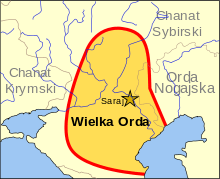Great Horde
The Great Horde was a Tatar-Mongol khanate that existed from about 1466 to 1502.[1][2] It was the steppe remnant of the Golden Horde.

Dissolution of the Golden Horde
The peripheral regions of the Golden Horde broke off as follows: 1438: Kazan Khanate, 1441: Crimean Khanate, 1466: Astrakhan Khanate. The remnant, which became known as the Great Horde, was left with the steppe between the Dnieper and Yaik, the capital Sarai and a claim to represent the tradition of the Golden Horde. By the 1470s, the Nogais north of the Caspian were hostile to the Great Horde and, in the west, Poland-Lithuania was expanding along the Dnieper.
In 1480, Muscovy and Crimea formed an alliance against the Great Horde which in turn allied with the Grand Duchy of Lithuania under Casimir IV Jagiellon. In 1480, the Great Horde's attempt to invade Muscovy failed. In 1481, Akhmat Khan was killed by the Nogais. He was succeeded by his son Shaikh Akhmat. After this, the Horde was weakened by conflicts among Akhmat's sons.
In the spring of 1491, the Crimean Khan suggested that Moscow send troops to finish off the Great Horde since he had "seized all the Horde's horses". Moscow sent some Tatar and Russian cavalry and the Ottomans sent 2,000 Janissaries. By November, part of the Horde had seceded and the remainder had been routed by the Nogais. By 1500, it was reported near the Kuban and in very bad shape after having been beaten by the Kabardinians. In 1501, Shaikh Akhmat Khan and 20,000 of his people moved north of the Don. Many of his people deserted.
In 1502, the Crimean Khan seized most of the Great Horde's people and herds and moved them to the Crimea (sometime before July 3 and somewhere near the Sula River). Shaikh Akhmat fled. He was next reported near Kazan with 4,000 horsemen negotiating with Muscovy. He then went to Astrakhan from which he was expelled by the Nogais (1504). He then moved to Kiev to deal with the Polish king and then to Akkerman to deal with the Ottomans. He was last reported as a Lithuanian prisoner at Vilna.
Khans of Great Horde
- (1435—1465) Sayid Ahmad I
- (1465—1481) Ahmed Khan, son of Küchük Muhammad
- (1481—1481) Sayid Ahmad II, son of Ahmed Khan
- (1481—1481) Ibak Khan, occupation by Sibir
- (1481—1485) Murtaza, son of Ahmed Khan
- (1485—1487) Sayid Ahmad II, second time
- (1487—1487) Ibak Khan, occupation by Sibir again
- (1487—1491) Murtaza, second time
- (1491—1491) Meñli I Giray, occupation by Crimea
- (1491—1495) Ibak Khan, occupation by Sibir again
- (1495—1502) Sheikh Ahmed, son of Ahmed Khan
Other uses
The Nogais and Kazakhs also had divisions called Great Hordes.
References
- Kimberly Kagan (2010). The Imperial Moment. p. 114.
- Bruce Alan Masters (2010). Encyclopedia of the Ottoman Empire. p. 159.
- Khodarkovsky, Michael (2002). Russia's Steppe Frontier.